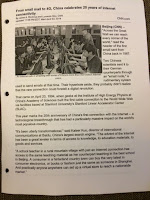Why I'm not Offended by a rise in homeschooling numbers
I recently came across the article,
Number of Homeschoolers Growing Nationwide, by Julia Lawrence from Education News. Although this article is a few years old, it remains a relevant topic in education today. Homeschooling has always been an interesting topic to me, even though I was raised through the public schooling ranks and even chose teaching, public school teaching, as my career. Needless to say, I have no personal experience within the area of Homeschooling, yet my feelings toward homeschooling have changed and developed over the years.
In short, the numbers of students engaged in homeschooling is going up and some of the stigmas that have historically plagued the choice are are being dropped. Home schooled students are scoring well on standardized tests and finding success at the next level, and even earning four-year degrees at a higher rate than students produced by the public school system.
Rather than take offense to homeschooling or try to argue against it, I have chosen to embrace the movement. Here are a few of the reasons that even as a public school teacher, who is also married to someone working within the public school system, I feel strongly about this.
Another point of view can often challenge or make one think about current practice. There are so many different and strong opinions about public education in our country. I believe that the tension that exists between those opinions ultimately benefits the public education system for good. Questions and challenges to current practice, whether it is about teacher evaluation, curriculum, or standards spur discussion and conversation that may not occur without difference of opinion.
Choice and individualized instruction is not a bad thing. Public education is not about a one-size-fits all approach. As many educators know, differentiating instruction is the only way to survive. Educators are constantly tweaking and adjusting lessons and plans to service the variety of students sitting in front of them. I may not be a 30-year veteran teacher, but I know enough to know that my classroom may not work for every given student in the country. There are so many factors that go into a student's success at any given time. Although I believe all students can learn and I strive to create an environment in my classroom in which that occurs, there may be something offered at home that I cannot provide.
Frankly, I respect a parent's parenting domain. We are lucky to live in a country where differing worldviews and lifestyles are prevalent and allowed. It may not be the same decision I would make, but I fully support a parent's choice in how their child is educated. Whether it is religion, content delivery, schedule, pace, etc. that spurs the decision to home school their child/children, I believe it should be an option a parent can choose to make.




